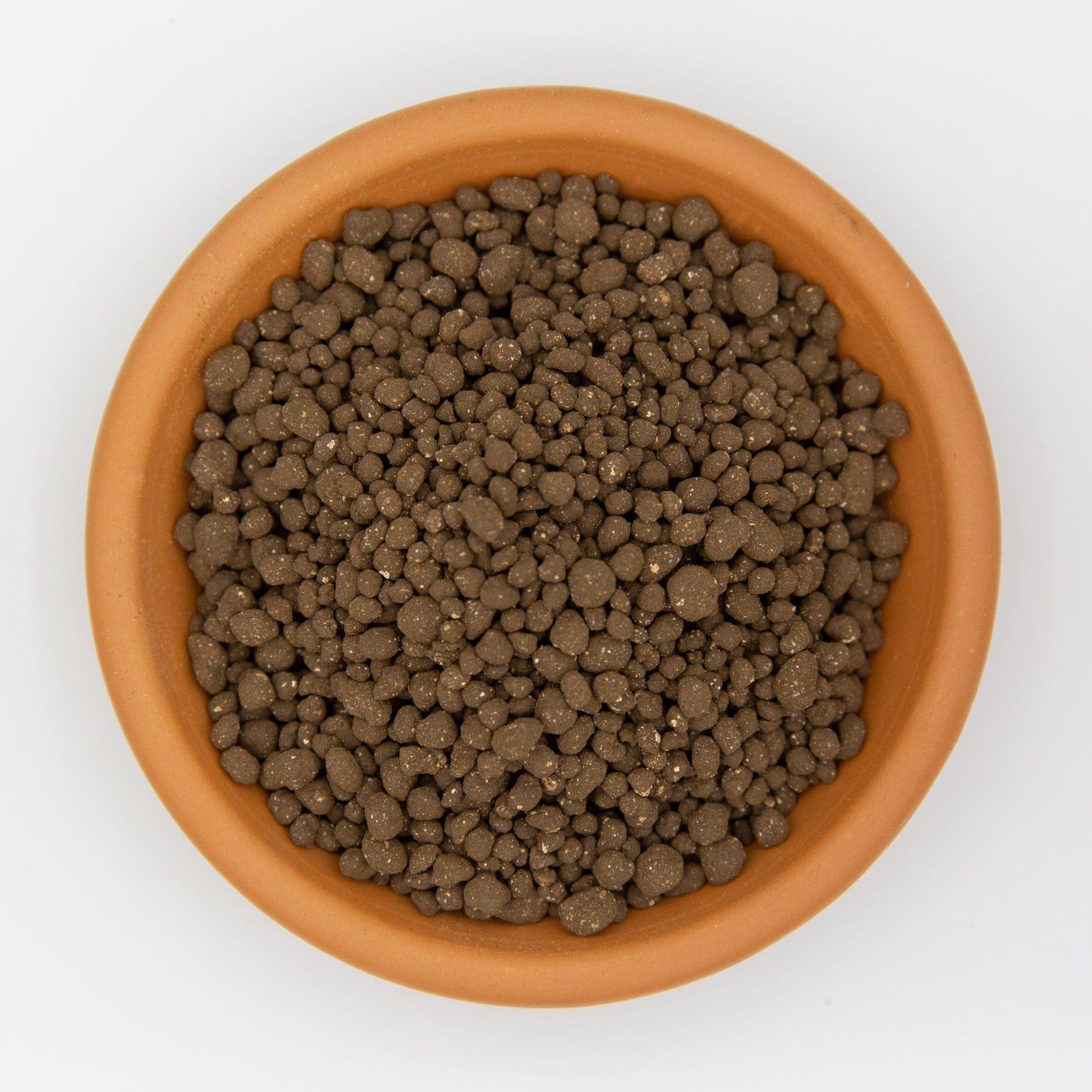Seabird guano is an all natural fertilizer made from the excrement of seabirds including seagulls & pelicans. It is abundant in a wide spectrum of crucial nutrients, including as phosphorus, silica, and other trace minerals. By supplying vital nutrients and encouraging the development of advantageous microbes, seabird guano is renowned for its capacity to enhance soil health and fertility.
Guano is an essential amendment for your garden to promote vigorous root growth and winter hardiness. Plants deficient in phosphorus will display stunted growth and often have an abnormally dark green color to the leaves.Contains a 50/50 split of citrate soluble and insoluble phosphorus, this means an inital and prolonged release in the soil for up to 6 months.
Use at 50-100g per square meter of vegetable garden or 250-400g per fruit tree.
Typical analysis – Nitrogen 0.11%, Phosphorus 11.17%, Potassium 0.25%, Sulphur 0.12%, Calcium 34.79%. Silica 8.80%
Other advantages:
- Seabird Guano contains a wide spectrum of vital nutrients, such as phosphorus, silica, and other trace minerals.
- It will help increase soil life by incorporating vital macro and micro nutrients by encouraging the development of specific microbes that are responsible for signaling plants to begin producing terpenes and flavonoids.
- Is used as a natural source of slow release phosphorus.
- Seabed Guano can aid in increasing aeration, water retention, and soil structure by activating soil microbiology and earthwork activity.

FAQs:
What actually is seabird guano?
It’s naturally mineralised seabird droppings that have built up and hardened over time. Ours is a dry amendment packed with phosphorus, calcium and silica, plus trace elements.
What’s the nutrient analysis?
Typical analysis: Nitrogen 0.11%, Phosphorus 11.17%, Potassium 0.25%, Sulphur 0.12%, Calcium 34.79%, Silica ~8.8%.
What does “50/50 citrate-soluble and insoluble phosphorus” mean?
Half the P is immediately plant-available, the other half releases slowly over months — so you get a fast kick and a gentle tail.
What does seabird guano do for plants, in plain English?
Bigger, stronger roots and better flowering/fruiting. The calcium supports cell walls (think firmer fruit and fewer disorders), and the silica helps overall plant resilience.
Who is seabird guano best for?
Heavy feeders and flowering/fruiting crops: tomatoes, capsicums, chilies, cucumbers, squash, pumpkins, corn, berries, vines, roses, bulbs, and most fruit trees.
Who should avoid seabird guano or go super easy?
Australian natives and other phosphorus-sensitive plants (proteas, grevilleas, banksias, hakeas). If you must, use a tiny fraction of the rate and monitor.
How much should I use in garden beds?
50–100 g per square metre. Mix into the top 5–10 cm of soil and water in well.
How much for fruit trees?
250–400 g per tree, spread over the dripline and watered in. Big old trees can take the upper end.
Can I use seabird guano in pots/containers?
Yes — it’s strong on P, so go light: around 1–2 teaspoons per 10 L of potting mix at pot-up, or top-dress the same amount monthly during active growth and water in.
Is seabird guano good for seedlings or seed-raising mixes?
Not really. Seedlings don’t need that much phosphorus. Wait until you pot up or plant out, then start with very light rates.
When should I apply seabird guano?
At planting/bed prep for root establishment, then again just before flowering or fruit set. For long seasons, a light mid-season top-up is fine.
How long does seabird guano feed for?
Up to ~6 months thanks to the slow-release fraction, soil biology, and its calcium backbone.
Can I brew a “guano tea” for faster uptake?
Yes. A simple approach: 1–2 tablespoons per 4 L of water, aerate/steep 12–24 hours, then drench soil. Strain before using to avoid clogging watering gear. Use within a day.
Will seabird guano burn plants?
Only if you overdo it. Stick to the rates above, especially in pots. When in doubt, use less, apply more often, and water in thoroughly.
Does seabird guano smell?
Our customers report minimal to no odour in the bag and after application. Any earthy whiff disappears once watered in.
Is seabird guano “certified organic”?
It’s purchased as an allowed certified-organic input. We don’t hold organic certification at our warehouse; the input itself meets organic input standards.
Is seabird guano the same as bat guano?
Different source, similar idea. Seabird guano is typically higher in phosphorus (great for roots/flowers). Bat guano products vary more — some are higher in nitrogen for leafy growth.
What about calcium — will seabird guano help things like blossom end rot?
It adds a lot of calcium, which supports fruit quality. Blossom end rot is also about uneven watering and root stress, so use guano plus consistent moisture and balanced nutrition.
Does seabird guano change soil pH?
It’s mildly alkaline due to the calcium. At the recommended rates it won’t drastically shift pH. If your soil is already very alkaline, lower the rate and rely more on composts/biostimulants.
Can I mix seabird guano with other amendments or fertilisers?
Yes. It plays well with compost, worm castings, kelp, fish hydrolysate and balanced N/K sources. Avoid stacking multiple high-phosphorus products at once.
Is seabird guano safe for edibles?
Absolutely. It’s a natural mineralised input. Brush off any granules from leaves/fruit, water in, and follow good garden hygiene.
Pet and kid safety?
Non-toxic but not a snack. Keep the bag away from pets/children and store sealed. If a dog hoovers some, you might see a tummy upset — call your vet if concerned.
Can I use seabird guano in hydroponics or drip systems?
No for standard recirculating hydro — it’s a particulate mineral amendment and will clog lines and throw systems out of whack. Soil and soilless blends are its lane.
Does seabird guano help soil life or is it just minerals?
Both. The mineral profile (especially P, Ca, Si) supports microbial activity, which in turn unlocks nutrients and improves structure and water-holding.
How should I apply as a top-dress?
Scatter lightly around the root zone (not piled at the stem), scratch into the top 1–2 cm, then water in or mulch over.
Can I add seabird guano to compost?
Yes, a small sprinkle per layer accelerates and mineral-balances the heap. Don’t go heavy — you’re seasoning, not salting chips.
Runoff or environmental concerns?
Any high-P product can cause problems if overapplied before heavy rain. Apply to moist soil, water in, and don’t broadcast onto hard surfaces.
How often should I reapply?
Beds: at prep and again pre-flowering/fruiting. Pots: tiny top-dress monthly in season. Always adjust to plant response.
What does “silica 8.8%” do for me?
Silica can improve stem strength and stress tolerance. It’s not a miracle, but it’s a nice bonus alongside the phosphorus and calcium.
Can I combine seabird guano with DRGT TurboDirt or your organic kits?
Yes. TurboDirt and our kits are balanced; if you want extra push for flowering fruiting crops, add a small dose of seabird guano at the flip or early bloom and watch plant response.
Any special watering tips after application?
Water in deeply to move fine particles into the root zone. Keep moisture even for the next week so microbes can get to work.
Storage and shelf life?
Store sealed in a cool, dry place. It’s stable for years; if it cakes, just break it up — performance is unchanged.
What’s the colour/texture supposed to be?
A pale, powdery mineral with tiny granules. That’s normal — it’s not pellets.
Is there any “break-in” period before I see results?
You’ll often see stronger growth within a couple of weeks, with the slow-release fraction continuing to support plants for months.
What if I think I added too much?
Flush the area with plenty of water, add compost or a carbon-rich mulch to buffer, and pause other phosphorus inputs for a while.
Can I use seabird guano as a foliar spray?
Not recommended — it’s a mineral powder and won’t fully dissolve. Keep it to soil applications or teas/drenches that are strained well.
Will seabird guano stain pavers or decks?
It can leave marks if left dry. Sweep up spills and hose hard surfaces immediately after use.
Does seabird guano attract pests?
Unlikely. It’s a mineral amendment, not a sugary attractant. Water in and cover with mulch to be tidy.
What size bags do you sell and where do I get them?
500 g, 1 kg, and 2.5 kg — online here or click-and-collect from our Bellambi, NSW store.
Got a weird situation and not sure on a rate?
Start at half the lowest suggested rate, watch plant response for 10–14 days, and scale up gently. You can always add more — you can’t un-add.
Please note: While this product is purchased by us from a supplier as an allowed certified organic input, we do not hold this certification within our premises.



